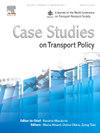研究COVID-19大流行对农村州老年人活动参与和模式使用的影响:以阿肯色州为例
IF 2.4
Q3 TRANSPORTATION
引用次数: 0
摘要
该研究的目的是调查COVID-19大流行对居住在以农村为主的阿肯色州的老年人的活动参与和模式使用的影响。利用从832名老年人参与者中收集的主要数据,该研究采用潜在类别分析(LCA)来捕捉老年人旅行行为的异质性,并发现了三个不同的类别:受大流行影响的最小旅行者、未受影响的非通勤汽车用户和未受影响的通勤汽车用户,显示出他们在大流行期间不同程度的活动参与、模式使用以及大流行对他们旅行的不同影响。为了根据老年人的社会人口统计学属性、居住地点和健康观念来理解这些变化,我们在LCA模型中添加了协变量来预测班级成员。班级成员模型的结果显示,班级之间存在明显差异。受大流行影响的最低限度旅行者(第1类)的特点是女性、社会人口特征低、失业、无驾驶身份、健康观念差、生活在农村地区。这一群体的活动参与和模式使用受到了更大的影响。相比之下,未受影响的非通勤汽车使用者(第二类)更可能是男性、白人、城市老年人,他们收入较高,对健康有更好的认识。尽管与第2类共享相似的社会人口特征,但未受影响的通勤汽车用户(第3类)在活动参与方面比非通勤者经历了更多的干扰。描述性统计结果显示,与购物和社交旅行相比,老年人的个人和工作旅行受到的影响相对较小。在模式使用方面,所有类别的汽车驾驶都受到了显著影响,受大流行影响的最小旅行者(1类)的减少尤为显著。在疫情期间,主动模式和非驾驶交通工具的使用率最低,对所有阶层的影响也最小。这些发现可以提供一些政策见解,包括解决不同老年人群体的独特需求,在解决性别差距、健康、交通、城乡差距等问题的政策之间建立联系,扩大家庭和社区在满足老年人交通需求方面的作用,提供旨在提高数字技能的方案,促进替代交通选择,并提高老年人在停止驾驶后制定计划的意识。本文章由计算机程序翻译,如有差异,请以英文原文为准。
Examining the impact of the COVID-19 pandemic on older adults’ activity participation and mode usage in a rural state: A case study of Arkansas
The objective of the study was to investigate the impact of the COVID-19 pandemic on the activity participation and mode usage of older adults residing in Arkansas, a predominantly rural state. Leveraging primary data collected from 832 older adult participants, the study employed Latent Class Analysis (LCA) to capture older adults’ heterogeneity in travel behavior and found three distinct classes: Pandemic-affected minimal travelers, Unaffected non-commuter car users, and Unaffected commuter car users, showing different levels of their activity participation, mode usage during the pandemic and varying the pandemic’s impact on their trips. To understand these variations in light of the older adults’ socio-demographic attributes, residential locations, and health perceptions, we added covariates in the LCA model to predict the class membership. Results from the class membership model revealed distinct differences among the identified classes. The Pandemic-affected minimal travelers (Class 1) were characterized by being female, having low socio-demographics, unemployment, non-driving status, poor health perceptions, and living in rural areas. This group experienced a greater pandemic impact on their activity participation and mode usage. In contrast, the Unaffected non-commuter car users (Class 2) were more likely to be male, White, urban older adults with higher incomes and better health perceptions. Despite sharing similar socio-demographic characteristics with Class 2, Unaffected commuter car users (Class 3) experienced more disruption in activity participation than non-commuters. Results from descriptive statistics showed that older adults’ personal and work trips were relatively less affected compared to their shopping and social trips. Regarding mode usage, car driving was significantly impacted across all classes, with the Pandemic-affected minimal travelers (Class 1) showing a particularly notable decrease. Active modes and non-driving transportation alternatives experienced minimal usage during the pandemic and also experienced a minimal impact across all classes. These findings can offer several policy insights, including addressing the unique needs of different groups of older adults, establishing connections between policies addressing the gender gap, health, transportation, rural–urban disparity, extending the role of family and communities in meeting older adults’ transportation needs, offering programs aimed at enhancing digital skills, promoting alternative transportation options, and raising awareness among older adults for making plans after their driving cessation.
求助全文
通过发布文献求助,成功后即可免费获取论文全文。
去求助

 求助内容:
求助内容: 应助结果提醒方式:
应助结果提醒方式:


